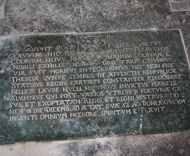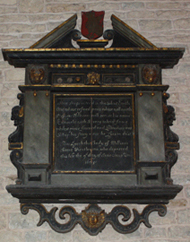The seventeenth is a well documented century. Together the continuing series of parish registers and the Church Wardens accounts (1631-1725) provide a glimpse of the concerns and common problems of daily life.(1) Two documents relate to the civil war years.(2) The Hearth Tax, first levied in 1662, its fuller records surviving for the 1670s,(3) and the almost contemporary Compton Census, carried out by the ecclesiastical authorities in 1676(4), can be used to set families in both their physical and their spiritual surroundings. So too can wills and inventories.
The settlement at Barcheston can have differed little from its present layout. The largest house was the rectory, rebuilt since its occupation by rector Lane (1546-1571). Its seven rooms, with their comfortable, stylish furniture and furnishings were listed in the two consecutive inventories of rectors Bulwer (d.1631) and Horton (d.1639)(5). However, the later Hearth Tax records show that the house had only six hearths. Surprisingly, the manor house, described in 1652 as much out of repair, had five; the miller John Wedge and the church warden, Henry Turner living in a cottage at the east end of the church now entirely rebuilt, had only one each. In 1599 Francis Hyckes, moved out of the manor house to live in Shipston on Stour where he was taxed and baptized his fourth child. Both Francis and his father Richard, then aged around 85, were relieved of their post in the royal household in 1609. The manor house was let for three lives to Sheldon’s shepherds, the Jobson family; the last holder died in 1647.(6)
It is much harder to portray Willington. Several late sixteenth- and early seventeenth- century wills indicate the rebuilding and enlargement of the testators’ dwelling house; subsequently many new names appear in the parish registers so that it is difficult to trace continuity of ownership. A clearer picture emerges from the Hearth Tax records of the 1670s. Twenty-one houses are listed, suggesting a population of around ninety people. Two had six hearths, belonging to William Brent and widow Freeman. John Ashby and Mr Henry Jones lived in properties with four hearths, Anthony Amsden and John Humphreys had three. All reflect respectable levels of prosperity. Richard Goodwin and Mistress Colborne, first mentioned in 1609 in the parish registers, had but two and thirteen dwellings had only a single hearth. Only one house had no hearth at all, that belonging to John Ashfield. The information is hard to relate to what now remains, to the tithe map of 1839 and to the earliest Ordnance Survey map of 1885.
The parish was apparently untouched by the agricultural unrest which swept across Warwickshire during the first decade of the century. It did not, however, escape the upheaval of the Civil War (1642-1647), its opening battle fought nearby at Edgehill.(7) Both settlements were taxed from 6 June 1643 at the weekly rate of £3 10s; the sum was divided evenly between them until July 1644 when the total paid amounted to £140. After that Willington’s obligation was reduced to only £1 5s while Barcheston was expected to raise £2 5s per week. Parliamentary troops were billeted in both settlements, not always with the wealthiest families, four times during the summer of 1644 when engagements took place all over the Midlands and armies crossed and re-crossed the roads to battle sites. Between June and September 1644 quarters were demanded and found for 1016 men and 232 horses.(8) The soldiers had to be fed; compensation was claimed for seventy-seven sheep, two calves, a flitch of bacon and a hogshead of beer in addition to provender and a bed with its furnishings supplied to the garrison at Compton Wynyates.
| June ‘44 Men/horses | July ‘44 Men/horses | July ‘44 Men/horses | August ‘44 Men/horses | Michaelmas ‘44 Men/horses |
| 947 /178 | 30/30 | 91/24 | 5/5 | 33/35 |
King Charles, however, was not entirely without local support. One Barcheston resident, Flamochus Colborne, born in the village in 1612, fought for the King, enlisting as a major of horse in the Earl of Northampton’s regiment. He survived and was buried in the south aisle in 1664.
The Sheldon family too, living nearby at Weston in Long Compton and owners of most of the land in Barcheston, were royalist and Roman Catholic; they became a target for petty abuses and minor despoliation.(9) Their lands, including ‘Barston Farm’ (ie the now dilapidated manor house) were confiscated in 1647; a survey was carried out before they were put on the market, valuing the income from 477 acres, all used as pasture, at £368 19s. William Sheldon’s fight to be allowed to buy back his property before its sale in 1653 to the man who had offered for them is recorded in the papers of the Committee for Compounding.(10)
William died in 1659. With the Restoration of king Charles II in 1660 came the full restitution of the family’s confiscated lands but not their fortune. His son Ralph ‘the Great’ Sheldon (1623-84) mortgaged lands in the parish to William Brent whose memorial is in the church, (British Library, Add Ms 36583, fo 16-17, 16 Jan 1680/81). The mill too was let again on the death of Daniel Wedge in February 1681, his family first known, from the parish registers, to have been in the village since the 1620s.(11)
Ralph died without heirs in 1684; the estate passed to his cousin Ralph Sheldon of Steeple Barton, Oxfordshire.(12)
A survey carried out by the ecclesiastical authorities, the Compton Census, listed, but did not name, thirty-two people over 16; all were Anglican. The four members of the older families prominent in Barcheston in the previous century who had been recorded as Catholics in a partially surviving tax return for 1629 were no longer living.(13)
The Church Wardens’ accounts record a mixture of costs for maintaining the nave and its roof and the expense of poor relief, usually for people passing through the parish rather than resident within its bounds. Many of these were in response to an appeal (a brief) from somewhere experiencing extreme hardship; sixteen months after the event the parish contributed 4s 3d. to the rebuilding of London after the Great Fire of 1666.
Minor maintenance – the re-slating of the porch and the scraping off of moss from the roof accompanied the much greater costs of recasting the bells in the Chacombe foundry (Northamptonshire) in 1634. A total of £11.1s 2d was spent – over £1000 in today’s money, a vast sum. Funds were raised in April 1631 by a rate of 2s 6d. levied on the old land measurement of the yardland, apportioned proportionately to ownership. Between them fourteen parishioners paid on 23 yardlands, Edward Sheldon on twenty-five, raising respectively £2.17s 6d and £3 2s 6d. Further expense was incurred after the discovery in June 1635 that the roof had been stripped of its lead. The same year Archbishop Laud (d.1645) decreed that the altar should be moved back to its older position against the east wall; following the execution of king Charles I the’ late king’s arms’ had to be removed in 1650; in 1660 on the return of his son Charles II they had to be restored.
Although the parish had been responsible since 1571 for the upkeep of its roads almost nothing seems to have been spent. Only when Shipston bridge needed repair in 1633 was 2s given to those who helped gather stones.
Though the accounts were painstakingly written out, it is surprising to discover how many of the churchwardens were unable to sign their own name.
The settlement’s physical appearance was altered by the enclosure of the open fields in Willington, a process which did not run smoothly.(14) Its building history, much of which originated in this century with its new inhabitants, has yet to be written.
References:
1. Parish Registers in WaCRO = DR 5/1-6, now on Ancestry, with many mistakes in transcription; Church Wardens’ Accounts 1626-1725 at WaCRO DR 5/6, narrative account by E A.B Barnard, Old Barcheston (Warwickshire) 1626-1725, Evesham, 1927.
2. TNA SP 28/182; SP 23/1116.
3. WaCRO QS 11/10, f. 10v-11v, now in print The Warwickshire Hearth Tax, ed. Tom Arkell and Nathaniel Alcock, Dugdale Society, vol. 43, 2010, pp. 203-04.
4. The Compton Census, of 1676, ed. Anne Whiteman and Mary Clapinson, 1986, pp. 173, 183.
5. E.A. Fry, Worcester Wills, British Record Society, vols 31,39, (1904, 1910) lists wills until 1649; thereafter indexes are at Worcester History Centre where the wills are stored.
6. http://www.tapestriescalledsheldon.info/pdfs/NEWPP36BIOGF_Hyckes.pdf. Worcester wills, Jobson 1613/204i, 1640/125(i), 1647 TNA PROB 11/199/ 102.
7. http://www.bbc.co.uk/history/british/civil_war_revolution/
8. TNA SP 28/182 (Willington in Barston) http://yourarchives.nationalarchives.gov.uk/index.php?title=SP_28/182_Barcheston. Surrounding villages also had to house troops.
9. Sheldon’s statement of the total damage suffered on his estates has been reprinted by E. A. B. Barnard, The Sheldons, (Cambridge 1936), p. 49-50 and more recently by Philip Tennant, The People’s War in the South Midlands 1642-45, Banbury History Society, vol. 23, 1992, pp. 68, 118, 138, 138-9, 210.
10. TNA SP 23/1116, nos 1011-16, http://yourarchives.nationalarchives.gov.uk/index.php?title=SP_23/1116 and Calendar of the proceedings of the Committee for Compounding, part III 1647-50, edited M A E Green (London 1891) pp. 1953-55.
11. Par Reg; his will proved 1684, TNA PROB 11/376.
12. A very brief biography is in Oxford Dictionary of National Biography.





